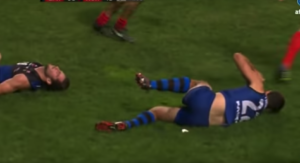 The first confirmed case of chronic traumatic encephalopathy (CTE) in a former AFL player has been reported by neuroscientists at the Australian Sports Brain Bank.
The first confirmed case of chronic traumatic encephalopathy (CTE) in a former AFL player has been reported by neuroscientists at the Australian Sports Brain Bank.
While many cases of CTE have been reported in American Football and two in Rugby League, scientists say the discovery in AFL could have major implications for concussion management in Australia’s most popular football code if repetitive head injury is found to be a common factor in the development of CTE.
The ‘index case’ was a former player who died in his 90s and whose brain was donated to the Sports Brain Bank had played over 350 first-grade ARL matches of ARF over 19 years. He was diagnosed with early-onset dementia at the age of 64, with personality change, depression and anger/aggression issues. He had slowly progressive memory loss until a distinct acceleration in the last five years of life.
Neuropathologists found that the man’s brain showed neuropsychological features commonly described in pathologically confirmed CTE cases from other sports. These included more severe frontal and temporal lobe atrophy and greater phosphorylated tau (pTau ) accumulation. His severe (stage III) CTE was accompanied by intermediate Alzheimer Disease-neuropathologic change, and severe small vessel disease.
The investigators acknowledged there were no criteria for distinguishing Alzheimers-associated pTau pathology from CTE-associated pathology, but said there were conformational differences in the β-helix region of pTau in CTE versus Alzheimers, suggesting that these are two distinct pathologies,
“Development of conformation-specific antibodies specific for CTE-pTau would greatly assist in distinguishing these two diseases,” they wrote.
Study investigators, led by Dr Alan Pearce (PhD) a neuroscientist and Victorian manager of the Sport Brain Bank, said it was not surprising to see high rates of concussion and traumatic brain injury in a sport in which high-force collisions are commonplace.